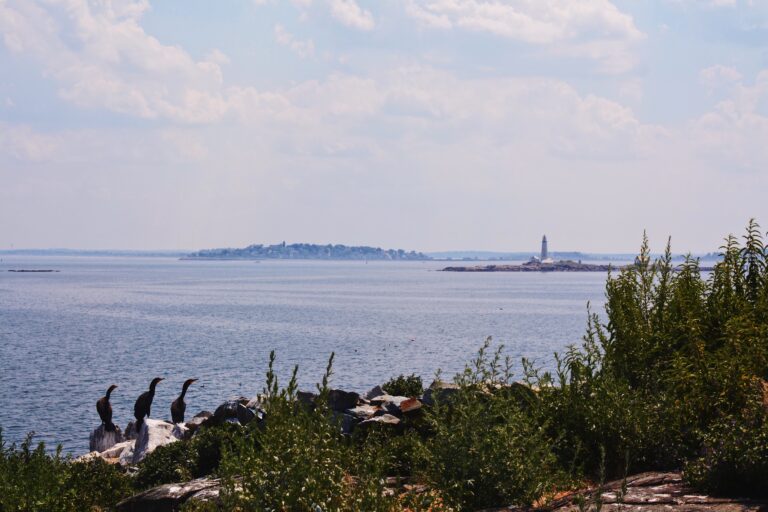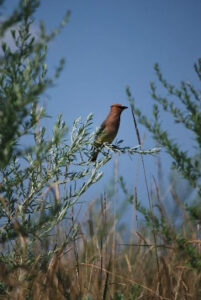Birds of the Islands

They swoop. They dive. They soar on the breeze. They call, sing, chirp and screech whether on a perch, on the wing, or in the water. These are just a few of the regular activities of the birds found in and around the Boston Harbor Islands.
Birds make up a large portion of the wildlife seen on the islands. Visitors can often spot Red-winged Blackbirds, Double-crested Cormorants, Great Black-backed and Herring Gulls, and Common Eiders. They can also see the acrobatics of the jewel-toned Tree and Barn Swallows, the bright yellow of an American Goldfinch or even hear the gobble of a wild turkey. The Boston Harbor Islands play home and host to a variety of birds, even some birds that are listed as Endangered or species of Special Concern by the federal and state government.
In 2001, an inventory survey was completed on the islands on its flora and fauna. The survey determined the Boston Harbor Islands meet the criteria established by Mass Audubon as an Important Bird Area. The islands qualify in three categories:
– The islands provide an important site for long-term research, education and bird conservation.
– More than 1,000 shorebirds utilize the islands at some point during the year. Shorebirds include woodcocks, sandpipers and piping plovers, which are state-listed as endangered and threatened respectively.
– The islands regularly support more than 500 waterfowl birds. Waterfowl include ducks, geese and coots, as well as loons and grebes, which are also state-listed as species of Special Concern and Endangered.
Many birds rely on the Boston Harbor Islands as an important landing point during nesting and seasonal migration. Grape, Hangman and Sheep Islands are home to many birds, and birds like herons, egrets, gulls and cormorants nest on Sarah and Sheep Islands. During nesting season, visiting these islands is discouraged as the birds can act territorial over the area.
Diets for the Islands birds vary widely. Gulls, for instance, are opportunistic feeders that will readily search and eat fish, mussels, crustaceans, insects and eggs. According to Mass Audubon, analysis of bird pellets unfortunately shows the gulls also eat different plastics and other garbage items that make their way into the water. Common, Least and Roseate Terns, birds listed as species of Special Concern or Endangered, eat a similar diet of fish and other seafood as gulls do, as well as catching insects. Terns are likely to forage for food near their nests, but will travel up to three kilometers (around 1.8 miles) when there is plenty of prey.
Red-winged Blackbirds, Tree and Barn Swallows eat insects like mosquitoes, spiders, flies, flying ants and other winged insects. Blackbirds, Goldfinches and American Tree Sparrows eat the fruits and seeds that grow on the islands. Wild turkeys, which are found at least on Spectacle and Grape Island, eat roots, seeds, bulbs, and berries. A common visual staple around most of Massachusetts these days, wild turkeys were extinct in the state in 1851. In 1972, the MA Division of Fisheries and Wildlife, which eventually became Mass Wildlife, received permission to trap and release 37 wild turkeys from near by states. A recent fall count of wild turkeys show they number near 20,000.
Birds of prey are also seen on and around Boston Harbor Islands. Red-tailed and Red-shouldered Hawks have been seen soaring between the islands. Threatened species like Northern Harriers and species of Special Concern like Bald Eagles are also migrating residents. Bald Eagles and Ospreys primarily focus on a marine diet of freshwater and saltwater fish, they will also catch other prey animals and even carrion during the lean winter months. Snowy owls even make a migratory appearance at the islands some years as they fly to a “warmer” area.
If you visit one of the Boston Harbor Islands, share with a ranger the wildlife that you saw. You never know what may be a new resident or visitor of the islands!
Pictures of: American Goldfinch, Red-winged Blackbird, another of an American Goldfinch, Black-backed Gull, Cedar Waxwing, Double crested cormorants, Male/Female Eider Ducks, and Barn and Tree Swallows on Spectacle Islands dock, and a Killdeer.

All Photos: Adinah Greene
https://www.massaudubon.org/our-conservation-work/wildlife-research-conservation/bird-conservation-monitoring/massachusetts-important-bird-areas-iba/iba-sites/boston-harbor-islands-national-recreation-area. Last updated 2021.
https://www.massaudubon.org/learn/nature-wildlife/birds/wild-turkeys/about. Last updated 2021.
Klein, Christopher. The Boston Harbor Islands. Globe Pequot, 2020.
Sibley, David Allen. Sibley Birds East Field Guide to Birds of Eastern North America. Alfred A. Knopf, 2016, 2nd Edition.